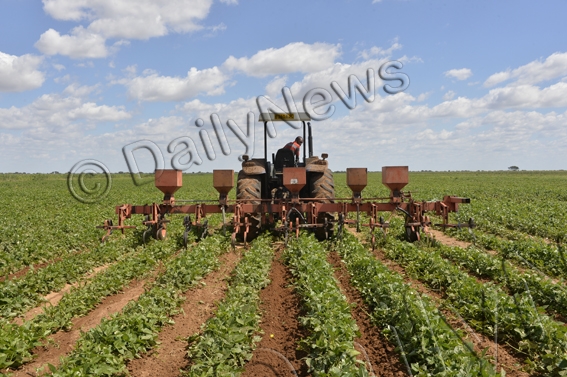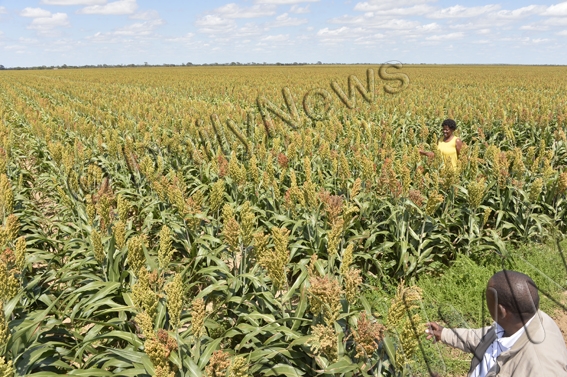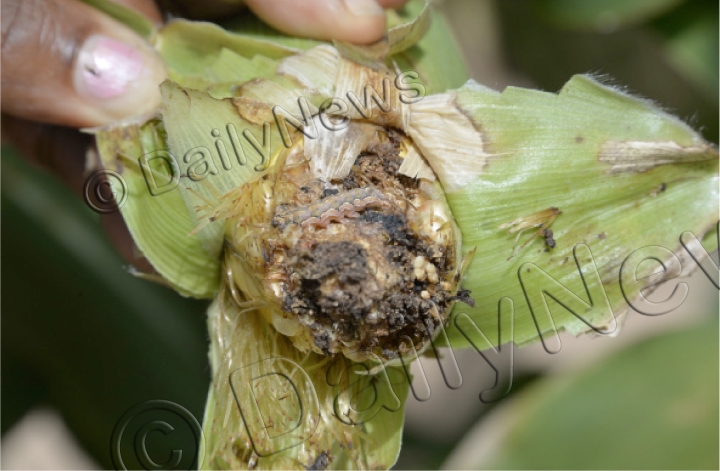Borolong Botswanas food basket back to glory days
25 Apr 2017
A drive along earthy, serene emerald vegetation down south gives one a gust of fresh air. The sweet melodious sounds of birds fill the air as they merrily grace the blue skies over farms in Ngwaketse South.
The fresh earthy, petrichor smell of rain captivates as I enjoy a ride along the neatly labelled commercial farms in Borolong. A flock of guinea fowls crossing the road is a sight to behold as they strut as though they own the world.
After a short while we make a stop by the road side at a farm labelled Dickson Baruakgomo where a man standing next to a steaming pot of mealie cobs shouts “Four Pula!” Clad in grey overalls and black gumboots, the man sells the mealie cobs with pride, his face beaming with a smile.
People occasionally stop by to relish the mealies here.
This farm forms part of the 18 commercial farms in Mosisedi where giant enterprising farmers in Jan Cronje, Molefhe Phirinyane, Otsile Dingalo, Oarabile Dingalo and other reputable local farmers have been clustered by government in an effort to drive Botswana to food security.
Their farms which cover huge acres of land are neatly ploughed in rows hosting a variety of crops such as maize, sorghum, cow peas, and ground nuts.
The area is undoubtedly endowed with good soils for crop production which Ngwaketse South chief crop officer Bontle Keoneeng attests to. “With a baseline of over 30 000 hectares (ha), the area is well known for its outstanding crop production activities and good soils.
Due to good rains this season, farmers responded in good time by ploughing.
The total area planted is 21 192.26 ha by 3220 farmers of which 67 per cent of them were subsistence farmers while 32.3 per cent are commercial farmers and 0.2 per cent are emerging farmers,” she says in an interview.
Borolong area receives about 300mm rainfall per annum and this year received about 3 000mm as compared to previous years.
“2016/2017 was the wettest year.
We recorded 1 359.93mm in January and 2 854.2mm in February,” she discloses, adding that these rains are expected to catapult production to greater heights for both subsistence farmers and commercial farmers.
The woman at the helm of Ngwaketse South crop production estimates increased produce for year 2016/2017 which she pegs at 21 192 metric tonnes (Mt) for subsistence farmers while commercial farmers are expected to produce 38 302 Mt.
Undoubtedly the area has greater potential of becoming the nation’s food basket after Pandamatenga Farms which has in 2016/2017 supplied Botswana Agricultural Marketing Board (BAMB) with sorghum grains of 25, 000 Mt and Pulses of 8, 000 Mt.
“It must be noted that their production may be more as they also supply millers and clients such as Choppies after supplying BAMB. In general most of the produce comes from the Southern part of the country,” says BAMB operations manager Mr Cornelius Mokgoko.
It goes without saying that in the past year crop production was affected by below normal rains which were poorly distributed nationwide.
In his State of the Nation address President Lt Gen. Dr Seretse Khama Ian Khama alluded to this when he said crop production was affected by periods of extended heat waves and low moisture levels.
The national cereal production for 2015/2016 was 54 374.20Mt which was about 18.1 percent of the national cereal requirement of 300 000 MT. Thus he said government was promoting climate smart Agriculture technologies such as conservation Agriculture.
Government has over the years encouraged Batswana to plough through Integrated Support Programme for Arable Development (ISPAAD) to support small farmers and put incentives in place such as 30 percent subsidies in farm inputs for commercial farmers.
Thus in his 2017/2018 budget speech Minister of Finance and Economic Development Mr Kenneth Matambo said Ministry of Agricultural Development and Food Security was allocated 5.9 per cent of the national budget at P983.71 million which include support ISPAAD amongst many others.
This he said ensured improved food security which enabled the citizens to become more resilient and ensure that they participate in economic activities that improve their livelihood.
However, Jan Cronje perhaps one of the country’s best commercial farmers does not let grass grow under his feet.
He has been based at Mosisedi for the past 6 years and wants improvements done to the ISPAAD programme, “small farmers who are enrolled in this programme should be assessed and be upgraded accordingly, if a farmer continuously fails to produce under ISPAAD but government keeps on enrolling them then this becomes ineffective.
We must use ISPAAD to produce good farmers,” says Cronje at his 900 ha farm where he expects 3.5 Mt in crop yield.
He succeeds because he cuts no corners but rather micro manages production, “I walk for about 5-7 km a day to check for worms, for pests, weeds and diseases.
If I find something I can pick a leaf and take it to an Agricultural Demonstrator because it looks different from the other ones.
The results could be that we didn’t put enough nutrients in the soil and next time I will know what to do.
Sometimes I engage consultants to do soil samples and they can tell if the field has run out of phosphorus, the soil PH has to be balanced all the time,” he says. “As a commercial farmer your profit must keep on rising.
We must be reliable in servicing the loans that we get from National Development Bank.
Bad management decisions will put you out of business, it’s important to prepare fields as early as possible and be on the look-out for new products and farming technologies in the market,” he emphasises.
While others want more labour force in the farm he says technology should be improved to reduce the labour force.
“It’s important to work towards the highest yield over time.
Yes technology is expensive, and it is moving fast.
The current technology is blue tooth driven and we must make the best with what we can afford,” he notes.
Another commercial farmer in Mosisedi, Mr Oarabile Dingalo does not expect much produce from his 500 ha field which was massively affected by Datura Pherox Stramonium (Mokhure) weed and also natural disasters such as hail which affected his over 300 ha of his field.
“We ploughed during rains and so as crops grew rains continued to fall and this did not give us time to apply herbicides,” says one of his workers spraying the seemingly stunted and yellowish leaved maize crops which were hit by hail.
The commercial farmers in the area use highly sophisticated farm implements which come with their own challenges.
“For example we use the modern tractor New Holland T8.390 which if we encounter a break down we have to order parts from South Africa, Lautenberg and sometimes we do not find them, sometimes we have to wait while they look for them from other areas in South Africa which may take over a month and meanwhile the soil loses its moisture content, so these are complications that we encounter,” he says.
Meanwhile the farmers in the area use Cronje’s sophisticated herbicide technology machine which covers large acres of land and can also de-worm the crops at a fee.
“We need government to help us with herbicide helicopter to enable us to manage weeds and de-worm the crops,” decries another commercial farmer, Molefhe Phirinyane who is currently managing about 1,000 ha of field where he planted sorghum, maize and beans.
Other farmers in the area such as Dickson Baruakgomo also want the helicopter.
The recent torrential rains have also brought damage such as the fall of army worm which invaded the sub district damaging maize and sorghum thus affecting production, says Keoneeng.
However she says all is not lost as farmers have been mobilised to control pests using pesticides such as cypermethrin, methomex and others.
The area has noxious weeds such as mokhure and cynodon dactylon weed referred to as motlho in Setswana.
“These weeds have been very problematic in the area and we expect them to reduce the yield by 30 per cent especially in the subsistence farmers’ category,” she projects. ENDS
Source : BOPA
Author : Calviniah Kgautlhe
Location : MOSISEDI
Event : Feature
Date : 25 Apr 2017









